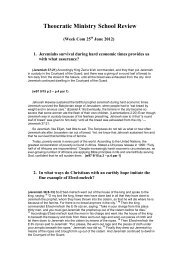1964 Awake! - Theocratic Collector.com
1964 Awake! - Theocratic Collector.com
1964 Awake! - Theocratic Collector.com
You also want an ePaper? Increase the reach of your titles
YUMPU automatically turns print PDFs into web optimized ePapers that Google loves.
on the right of the horse, so the keep.-to.<br />
the-left rule was most advantageous in<br />
coping with the approaching charger.<br />
Britain always has kept to the left side<br />
of the road. Some say this is because Julius<br />
Caesar invaded the island in 56-55 B.c.<br />
and enforced the left-side rule. Britain's<br />
unwritten drive-on-the-Ieft rule was enforced<br />
by the courts in the late Middle<br />
Ages. It finally became a written law in<br />
Britain's Highway Act of 1835, which was<br />
sixty years before cars became the accepted<br />
mode of transport<br />
A later reason for the British keeping<br />
to the left was that the English wagon and<br />
carriage drivers preferred to drive seated<br />
on a box on the right-hand side of the<br />
coach so that they could use their whips<br />
freely, which were normally secured to<br />
the right-hand side of the seat. To facilitate<br />
their using their whips, they chose<br />
the left side of the road.<br />
In Continental Europe, however, instead<br />
of the carriage drivers riding seated on the<br />
carriage, they preferred to ride the horse<br />
nearest the left wheel of the carriage and<br />
drive on the right side of the road. This<br />
position would make it easier for them to<br />
see the approach of other carriages and<br />
facilitate passing on<strong>com</strong>ing vehicles.<br />
There is still another side to this story.<br />
Emperor Napoleon, some say, favored the<br />
right side of the road and established this<br />
rule in all countries he conquered. This<br />
may explain why the left-hand rule of the<br />
road was still in force in the Austro<br />
Hungarian Empire, Portugal and parts of<br />
Switzerland and Italy at the beginning of<br />
the present century, and is still in force in<br />
Iceland, the Republic of Ireland, Sweden<br />
and the United Kingdom.<br />
The Americans have always driven on<br />
the right of the road. Their choice was<br />
probably influenced by their admiration for<br />
the French, who drove on the right of the<br />
road.<br />
22<br />
Recent Changes Made<br />
In recent times several countries have<br />
changed from the left to the right side of<br />
the road. Many of these changes were<br />
made due to the country's being occupied<br />
by foreign military forces accustomed to<br />
the opposite rule of the road. There is no<br />
record of any country's ever changing<br />
from the right to the left side of the road.<br />
The possibility of a changeover from<br />
left to right is now being considered by the<br />
governments of West Africa and other<br />
countries. Sweden is considering a change<br />
probably in 1967, and Britain is to discuss<br />
changing the rule with Australia and New<br />
Zealand in the near future. In anticipation<br />
of a possible change, all future roads in<br />
England are being designed so that traffic<br />
can move on either the right or the left<br />
side of the road.<br />
Imponderables of Changeover<br />
The problems involved in changing from<br />
one side to the other are stupendous. For<br />
example, for Australia to change it is estimated<br />
that, with a warning Period of five<br />
years, a cost of £200 million would be involved<br />
simply to switch the steering mechanism<br />
of the three million cars on its roads<br />
from the right to the left side of the dashboard.<br />
The cost of changing the steering,<br />
pedals and panel instruments would range<br />
from £110 on a Volkswagen and smaller<br />
cars to over £300 on American and<br />
British-made, cars. In addition, Australia<br />
is planning on spending some £810 million<br />
within the next ten years on a roadbuilding<br />
program. It is not likely that the<br />
Australian will want to bear such a great<br />
financial burden without first settling this<br />
issue of changeover. But the problem of<br />
changeover does not end there.<br />
Let us assume an order was issued in<br />
the land where you live that on the following<br />
morning everyone in the country was<br />
AWAKE!




